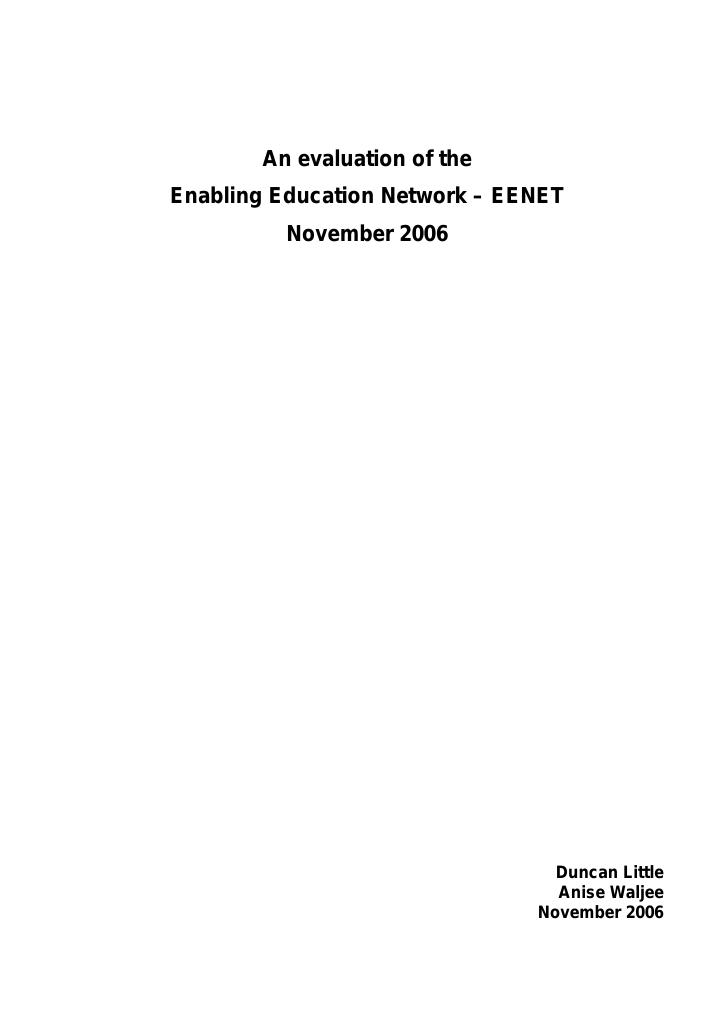Evaluering
An evaluation of the Enabling Education Network (EENET)
Background Evaluation done by Norwegian Association of Disabled. The evaluation was commissioned as a final evaluation of the partnership between EENET and NFU. Purpose/objective EENET entered its tenth year of operation in 2006. This is to be marked by an evaluation (which forms the subject of this report), a number of new materials and a celebratory event in January 2007. The evaluation was commissioned by NFU, one of EENET's principle financial supporters from 2000 until 2004. It sought to a) review EENET's development as a network from 2000 to 2005, b) assess the scope and impact of its work, and c) make recommendations for EENET's future priorities and sustainability. Methodology The two evaluators used a variety of methods for reaching both Northern and Southern users of EENET. These included interviews in person and on the phone, a detailed questionnaire to all users, and focus groups in East Africa and in the UK. Finally, a review of various materials was conducted: newsletters, annual reports and records kept by EENET. The review covered users, EENET staff, Northern NGOs and EENET supporters, steering group members and donors. Key findings To acquire Financial support from donors and Northern partners for more than 1 year at the time• EENET should lead and support regionalisation in the context of brandingRegionalisation needs to occur within a framework in which EENET provides a degree of leadership that reflects its core principles, its expertise and its special brand of networking. Recommendations A number of key recommendations covering EENET's work, identity, operations, impact, user perspectives and expectations and funding were distilled from the data and the discussions. These are set out below. Funding: A major task is to consolidate the gains made by EENET in the field of IE to ensure the future success and prosperity of the network. This evaluation has identified a number of possible ways forward, but EENET needs the financial security over the next three years to explore these options. NFU and other donors, particularly those who have supported the network in the past and/or benefit from its services, should consider providing EENET with that 'breathing space' for three years. This would help it gain a solid financial base for its evolution and activities. Website design and navigation: There is evidence that a majority of those users who responded to the survey are now using the Internet to access EENET's resources.There is a need to redevelop the site so that the increasing group of Southern users who do have Internet access can more quickly and directly access the information they require. This could then make the site more accessible to more users, even in places with very poor or slow Internet connections.Readability: While some users find EENET's material easily accessible, it did not score so well when put to a readability test. There is a need to increase the clarity and comprehension of text in EENET's own materials for its existing readership and for new users. EENET also needs to re-visit its website and review the readability of its webpages and other editable material at regular intervals. Articulation of EENET's identity: EENET needs to articulate more prominently what it stands for and what promising IE practice it draws on. Clearer guidance in all publications and on its website regarding what EENET does/does not do will help the network to develop better ways of explaining and promoting its activities. It will also help the network to articulate to itself what its future direction is going to be. This recommendation is also linked to the issues of branding , creating a higher profile for the network, and the general consensus that EENET should take a lead role in the process of regionalisation of the network. (See key recommendations 5, 11 and 12.)Building national and regional IE networks: There is a need, identified by evaluation respondents and during the focus group discussions, for EENET not just to continue supporting existing national and regional networks, but actively to help set up others and initially help them, in conjunction with Southern counterparts.Expanding operational structures: EENET needs to discover an overall structure that enables it to expand its work, document its operations and yet retain its very friendly and personal approach to people. Options include expanding its staff if funding permits (Section 6), reviewing the notion of regionalisation (Section 7), and the associated notion of branding (Section 8). The network needs to seek a long-term three-to-five year grant to review and re-shape its operations in order to do any of the above. Staffing levels: The size of the staff is now a serious constraint to the network's potential for making a unique contribution to issues of inclusion in the South and within major national and international policy arenas. However, the nature of EENET dictates that it expand in modest numbers to retain the very personal touch that it guards so carefully. EENET needs to look at a gradual expansion of between three and six people. According to its Northern supporters, this was felt to be an optimum size if it is to maintain its very personal approach and the characteristics that make it accessible to its users. Comments from the organisation EENET and NFU both see this as an accurate and very useful evaluation. EENET does not entirely agree with the way forward, as they do not necessarily see the need for a larger office with several employees.
